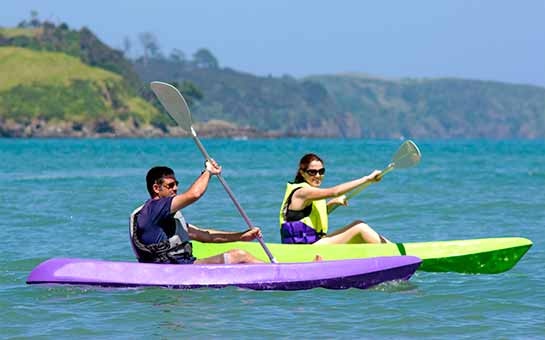For thousands of years canoeing and kayaking adventurers have spent their time on lakes, rivers and oceans. Paddlers of these watercrafts may enjoy a relaxing, low impact workout or fishing on lakes and lazy rivers. Whereas the more extreme paddlers can be found bouncing off and around rocks in whitewater rivers and turbulent oceans. Safety is of the utmost concern on any type of water, and with careful preparation you can ensure an exciting and safe adventure.
Travel Insurance for Canoeing and Kayaking
Medical care is one expense, and medical evacuation is another. Believe it or not the bill for the latter can actually be just as high as treating injuries sustained depending on the circumstances. While some medical plans may or may not cover injuries sustained from such a sporting incident, you certainly would want to know what your plan covers before the injuries are sustained and charges are incurred.
If you're ready to get out on the water, be sure to check your equipment, check the conditions of the water you are exploring, and check your insurance plan before you head out to make sure it will cover you if something were to happen while you are canoeing or kayaking. Many insurance plans consider canoeing and kayaking to be hazardous sports, and as such, even something as small as a scraped knee may not be covered. Give us a call and let us help you find canoeing travel insurance plan or kayaking travel insurance plan. Be safe, have fun, and let us help you make sure the insurance plan you purchase is the right one.
History of Canoeing and Kayaking
Canoes have been around for many years and have been used in many parts of the world by cultures like the Native Americans and the Australian Aboriginals. Like kayaks, canoes have evolved for specialized purposes. Most of the first canoes were made out of hollowed out tree trunks, and unlike kayaks, canoes generally will have an open top.
Kayaks are believed to have been first developed by the indigenous people of present day Alaska, Canada, Greenland, and Siberia. These were highly advanced watercrafts made from stitched seal, or other various animal skins stretched over a wood or a whalebone skeleton frame. The use of these water crafts were so important for areas of harsh weather that many specialized forms were created. Each model allowed for the specialization in a particular task. The Aleutian people were said to have been kidnapped by Russians for their skill of hunting sea mammals with their specialized water crafts.
What are Canoes and Kayaks Made Of?
These days, both canoes and kayaks are comprised of many different materials; plastic, polycarbonate, aluminum, fiberglass, lightweight wood, canvas or even nylon cloth. The intent of the use will generally determine the type of material used, as well as the seats available. Typically seating is limited to just one or two, some are made to hold a few more. The variation of uses are quite expansive from camping and recreation to military and sporting competitions. Canoes have paddles with a blade on a single end, while kayaks have a paddle with blades on each end.
Canoeing and Kayaking Destinations
Some popular locations for canoeing and kayaking in the United States are Lake Tahoe in Nevada/California, Colorado River in Arizona, Glacier Bay in Alaska, and the Ozark Mountains mainly in Missouri/Arkansas. Choosing the location of your adventure is one of the keys to success. Waters can vary greatly from place to place or even season to season. You will want to research areas for the best places to canoe or kayak.
Risks of Canoeing and Kayaking
There can be many dangers hidden in this seemingly safe sport. Preparation, as with anything, is one of the key components to minimizing your risk when participating in this sport. Beginners can find instructors in the more popular areas to help them learn the right way to canoe or kayak. Having the right equipment, especially safety equipment such as helmets and life jackets can make the difference between life and death. Although preparation and the right equipment can help minimize the risks of kayaking and canoeing, there is always risk.
Drowning, hypothermia, dehydration, heat stroke, impact injuries, sprains, and strains are just a few of the potential things that can happen, not to mention, the need for medical evacuation is high with water sports. While white water rapids may seem like a much higher risk than calm waters, do not be fooled, calm waters can pose a very real threat. It is never advisable for someone to venture out in any water sport by themselves and/or without someone knowing their plans or route. While the dangers between white water rapids and a calm descent down the river differ greatly, they each have the potential to cause a great need for medical attention.

